BMP6002 Strategic Management Individual Report on Unilever plc
VerifiedAdded on 2023/06/10
|11
|3087
|234
AI Summary
This report discusses the strategic management of Unilever plc, including Ansoff's Matrix, Bowman Strategy Clock, and McKinsey Matrix. It also includes SWOT and PESTLE analysis, and a business action plan to improve the quality of the company's products.
Contribute Materials
Your contribution can guide someone’s learning journey. Share your
documents today.
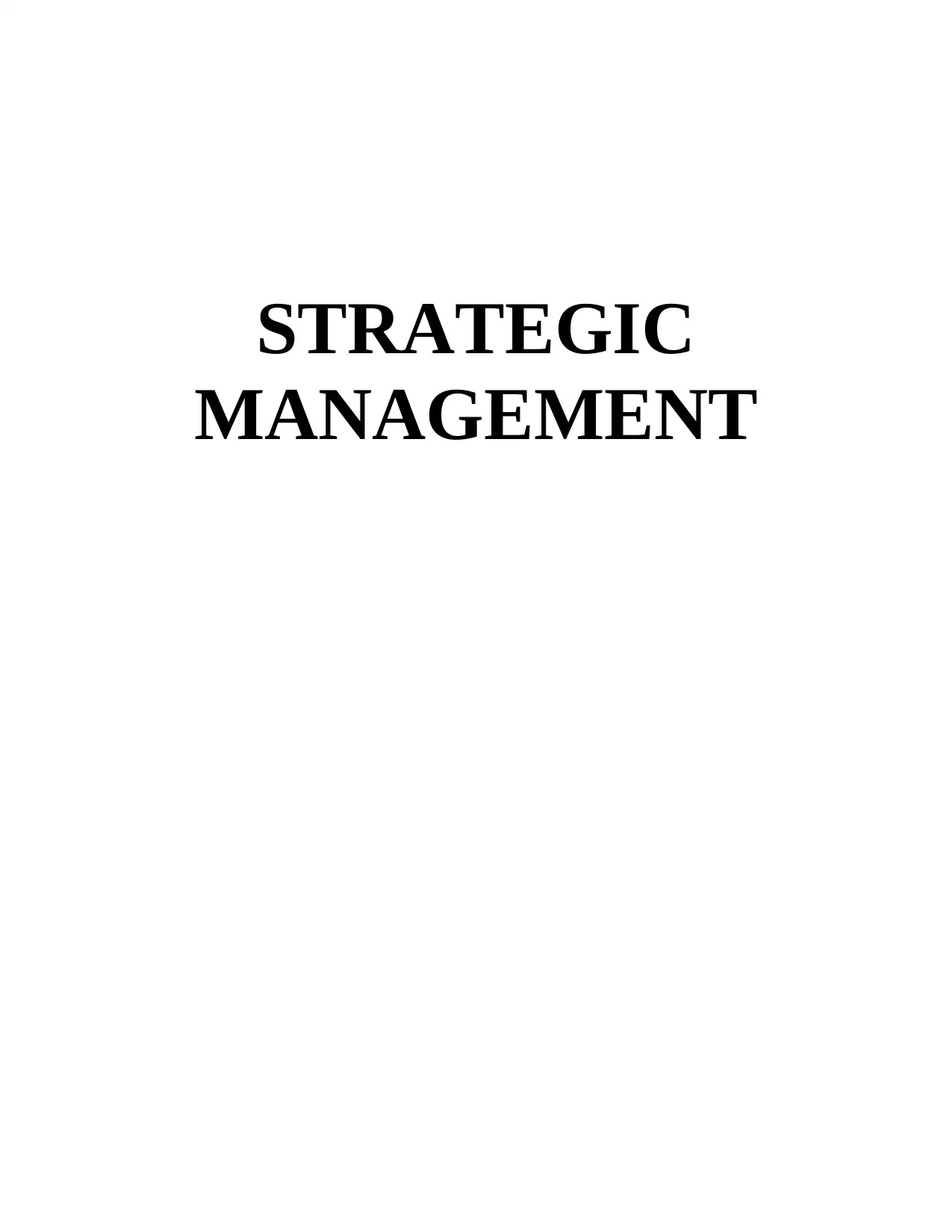
STRATEGIC
MANAGEMENT
MANAGEMENT
Secure Best Marks with AI Grader
Need help grading? Try our AI Grader for instant feedback on your assignments.
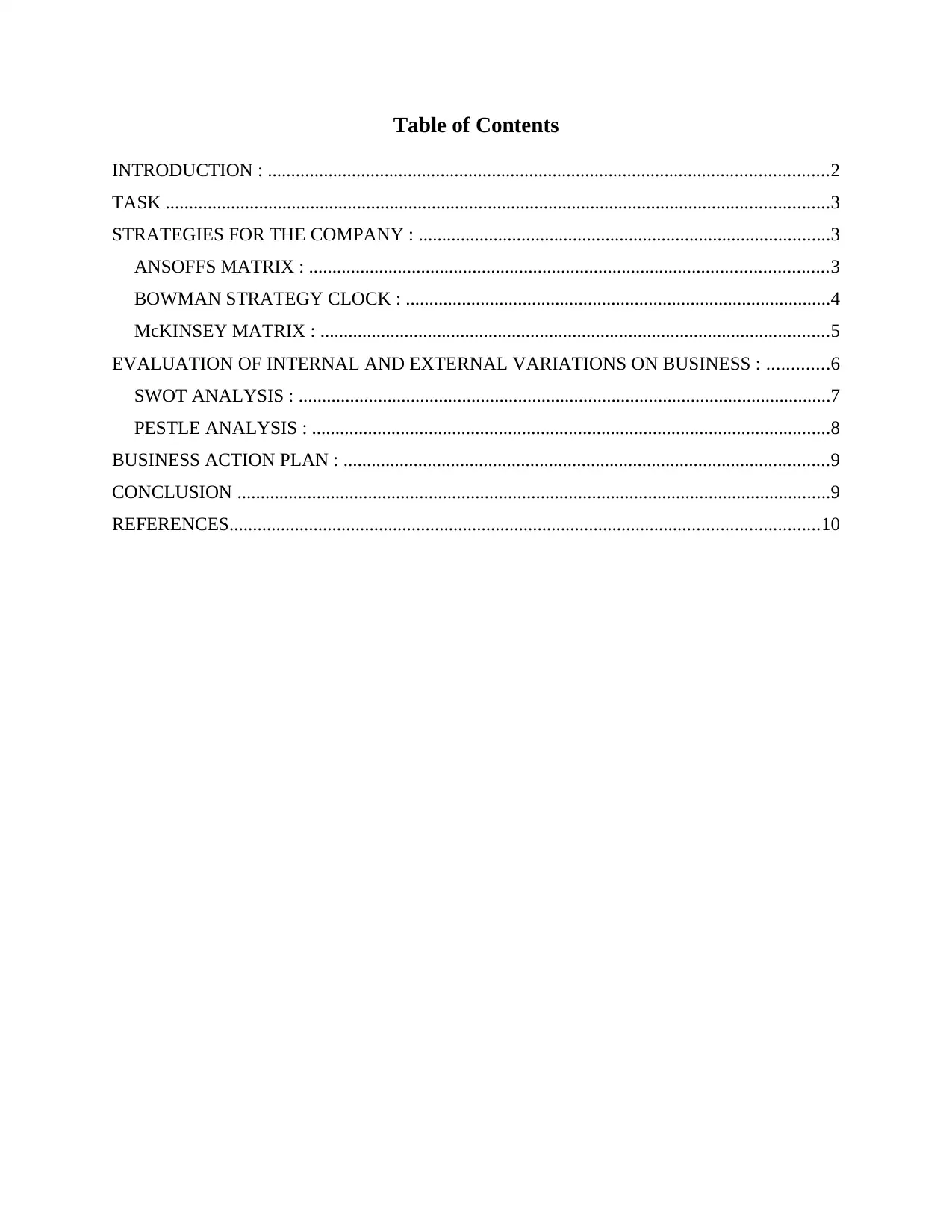
Table of Contents
INTRODUCTION : ........................................................................................................................2
TASK ..............................................................................................................................................3
STRATEGIES FOR THE COMPANY : ........................................................................................3
ANSOFFS MATRIX : ...............................................................................................................3
BOWMAN STRATEGY CLOCK : ...........................................................................................4
McKINSEY MATRIX : .............................................................................................................5
EVALUATION OF INTERNAL AND EXTERNAL VARIATIONS ON BUSINESS : .............6
SWOT ANALYSIS : ..................................................................................................................7
PESTLE ANALYSIS : ...............................................................................................................8
BUSINESS ACTION PLAN : ........................................................................................................9
CONCLUSION ...............................................................................................................................9
REFERENCES..............................................................................................................................10
INTRODUCTION : ........................................................................................................................2
TASK ..............................................................................................................................................3
STRATEGIES FOR THE COMPANY : ........................................................................................3
ANSOFFS MATRIX : ...............................................................................................................3
BOWMAN STRATEGY CLOCK : ...........................................................................................4
McKINSEY MATRIX : .............................................................................................................5
EVALUATION OF INTERNAL AND EXTERNAL VARIATIONS ON BUSINESS : .............6
SWOT ANALYSIS : ..................................................................................................................7
PESTLE ANALYSIS : ...............................................................................................................8
BUSINESS ACTION PLAN : ........................................................................................................9
CONCLUSION ...............................................................................................................................9
REFERENCES..............................................................................................................................10
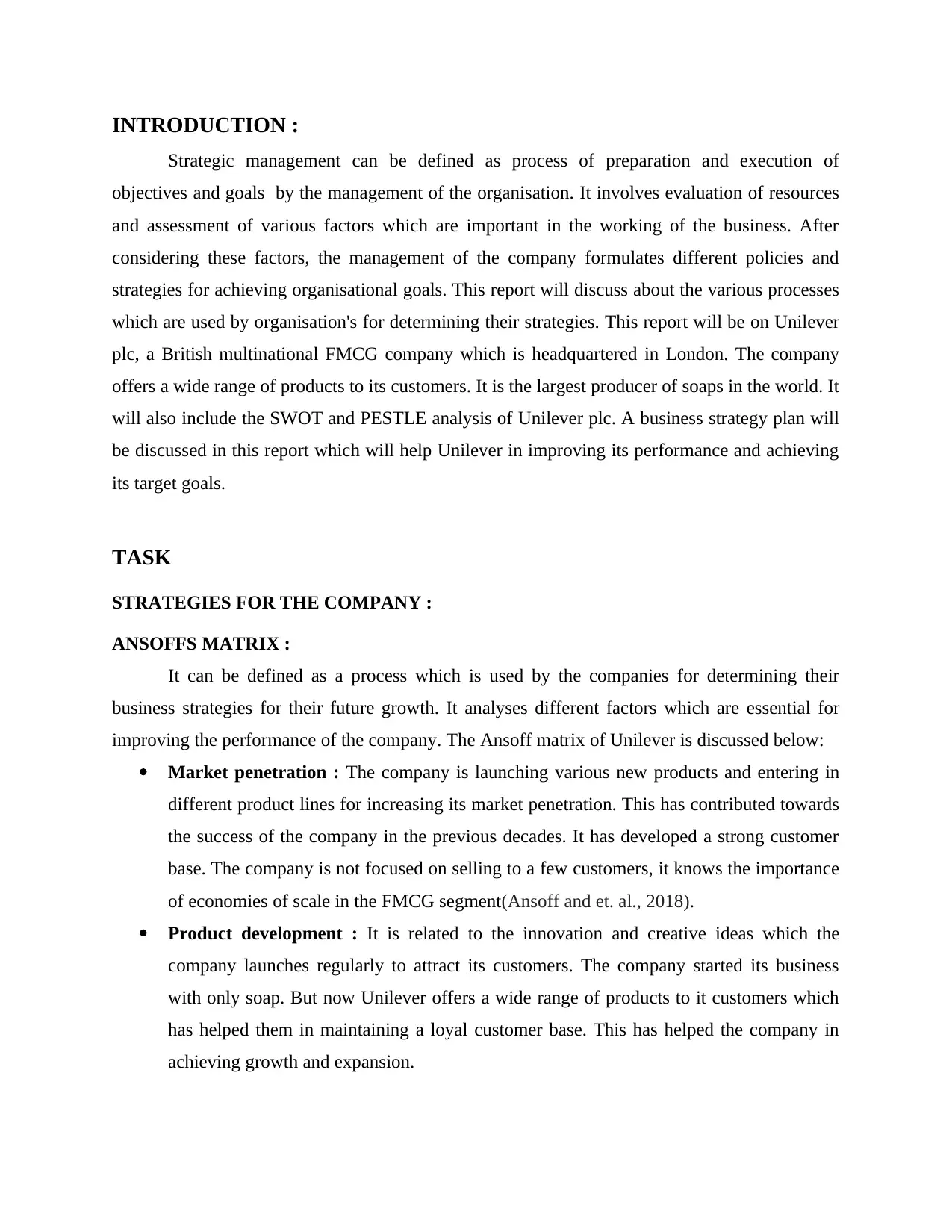
INTRODUCTION :
Strategic management can be defined as process of preparation and execution of
objectives and goals by the management of the organisation. It involves evaluation of resources
and assessment of various factors which are important in the working of the business. After
considering these factors, the management of the company formulates different policies and
strategies for achieving organisational goals. This report will discuss about the various processes
which are used by organisation's for determining their strategies. This report will be on Unilever
plc, a British multinational FMCG company which is headquartered in London. The company
offers a wide range of products to its customers. It is the largest producer of soaps in the world. It
will also include the SWOT and PESTLE analysis of Unilever plc. A business strategy plan will
be discussed in this report which will help Unilever in improving its performance and achieving
its target goals.
TASK
STRATEGIES FOR THE COMPANY :
ANSOFFS MATRIX :
It can be defined as a process which is used by the companies for determining their
business strategies for their future growth. It analyses different factors which are essential for
improving the performance of the company. The Ansoff matrix of Unilever is discussed below:
Market penetration : The company is launching various new products and entering in
different product lines for increasing its market penetration. This has contributed towards
the success of the company in the previous decades. It has developed a strong customer
base. The company is not focused on selling to a few customers, it knows the importance
of economies of scale in the FMCG segment(Ansoff and et. al., 2018).
Product development : It is related to the innovation and creative ideas which the
company launches regularly to attract its customers. The company started its business
with only soap. But now Unilever offers a wide range of products to it customers which
has helped them in maintaining a loyal customer base. This has helped the company in
achieving growth and expansion.
Strategic management can be defined as process of preparation and execution of
objectives and goals by the management of the organisation. It involves evaluation of resources
and assessment of various factors which are important in the working of the business. After
considering these factors, the management of the company formulates different policies and
strategies for achieving organisational goals. This report will discuss about the various processes
which are used by organisation's for determining their strategies. This report will be on Unilever
plc, a British multinational FMCG company which is headquartered in London. The company
offers a wide range of products to its customers. It is the largest producer of soaps in the world. It
will also include the SWOT and PESTLE analysis of Unilever plc. A business strategy plan will
be discussed in this report which will help Unilever in improving its performance and achieving
its target goals.
TASK
STRATEGIES FOR THE COMPANY :
ANSOFFS MATRIX :
It can be defined as a process which is used by the companies for determining their
business strategies for their future growth. It analyses different factors which are essential for
improving the performance of the company. The Ansoff matrix of Unilever is discussed below:
Market penetration : The company is launching various new products and entering in
different product lines for increasing its market penetration. This has contributed towards
the success of the company in the previous decades. It has developed a strong customer
base. The company is not focused on selling to a few customers, it knows the importance
of economies of scale in the FMCG segment(Ansoff and et. al., 2018).
Product development : It is related to the innovation and creative ideas which the
company launches regularly to attract its customers. The company started its business
with only soap. But now Unilever offers a wide range of products to it customers which
has helped them in maintaining a loyal customer base. This has helped the company in
achieving growth and expansion.
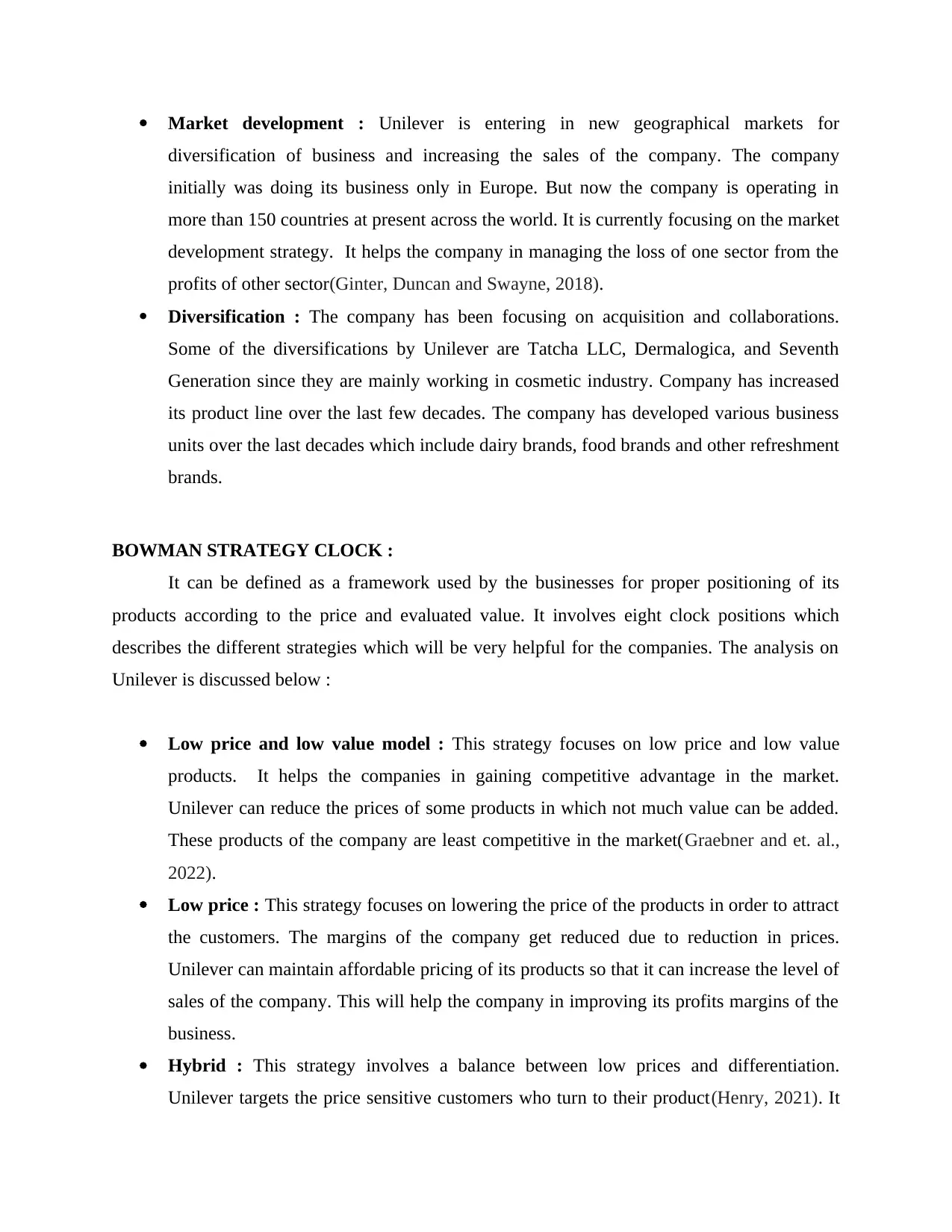
Market development : Unilever is entering in new geographical markets for
diversification of business and increasing the sales of the company. The company
initially was doing its business only in Europe. But now the company is operating in
more than 150 countries at present across the world. It is currently focusing on the market
development strategy. It helps the company in managing the loss of one sector from the
profits of other sector(Ginter, Duncan and Swayne, 2018).
Diversification : The company has been focusing on acquisition and collaborations.
Some of the diversifications by Unilever are Tatcha LLC, Dermalogica, and Seventh
Generation since they are mainly working in cosmetic industry. Company has increased
its product line over the last few decades. The company has developed various business
units over the last decades which include dairy brands, food brands and other refreshment
brands.
BOWMAN STRATEGY CLOCK :
It can be defined as a framework used by the businesses for proper positioning of its
products according to the price and evaluated value. It involves eight clock positions which
describes the different strategies which will be very helpful for the companies. The analysis on
Unilever is discussed below :
Low price and low value model : This strategy focuses on low price and low value
products. It helps the companies in gaining competitive advantage in the market.
Unilever can reduce the prices of some products in which not much value can be added.
These products of the company are least competitive in the market(Graebner and et. al.,
2022).
Low price : This strategy focuses on lowering the price of the products in order to attract
the customers. The margins of the company get reduced due to reduction in prices.
Unilever can maintain affordable pricing of its products so that it can increase the level of
sales of the company. This will help the company in improving its profits margins of the
business.
Hybrid : This strategy involves a balance between low prices and differentiation.
Unilever targets the price sensitive customers who turn to their product(Henry, 2021). It
diversification of business and increasing the sales of the company. The company
initially was doing its business only in Europe. But now the company is operating in
more than 150 countries at present across the world. It is currently focusing on the market
development strategy. It helps the company in managing the loss of one sector from the
profits of other sector(Ginter, Duncan and Swayne, 2018).
Diversification : The company has been focusing on acquisition and collaborations.
Some of the diversifications by Unilever are Tatcha LLC, Dermalogica, and Seventh
Generation since they are mainly working in cosmetic industry. Company has increased
its product line over the last few decades. The company has developed various business
units over the last decades which include dairy brands, food brands and other refreshment
brands.
BOWMAN STRATEGY CLOCK :
It can be defined as a framework used by the businesses for proper positioning of its
products according to the price and evaluated value. It involves eight clock positions which
describes the different strategies which will be very helpful for the companies. The analysis on
Unilever is discussed below :
Low price and low value model : This strategy focuses on low price and low value
products. It helps the companies in gaining competitive advantage in the market.
Unilever can reduce the prices of some products in which not much value can be added.
These products of the company are least competitive in the market(Graebner and et. al.,
2022).
Low price : This strategy focuses on lowering the price of the products in order to attract
the customers. The margins of the company get reduced due to reduction in prices.
Unilever can maintain affordable pricing of its products so that it can increase the level of
sales of the company. This will help the company in improving its profits margins of the
business.
Hybrid : This strategy involves a balance between low prices and differentiation.
Unilever targets the price sensitive customers who turn to their product(Henry, 2021). It
Secure Best Marks with AI Grader
Need help grading? Try our AI Grader for instant feedback on your assignments.
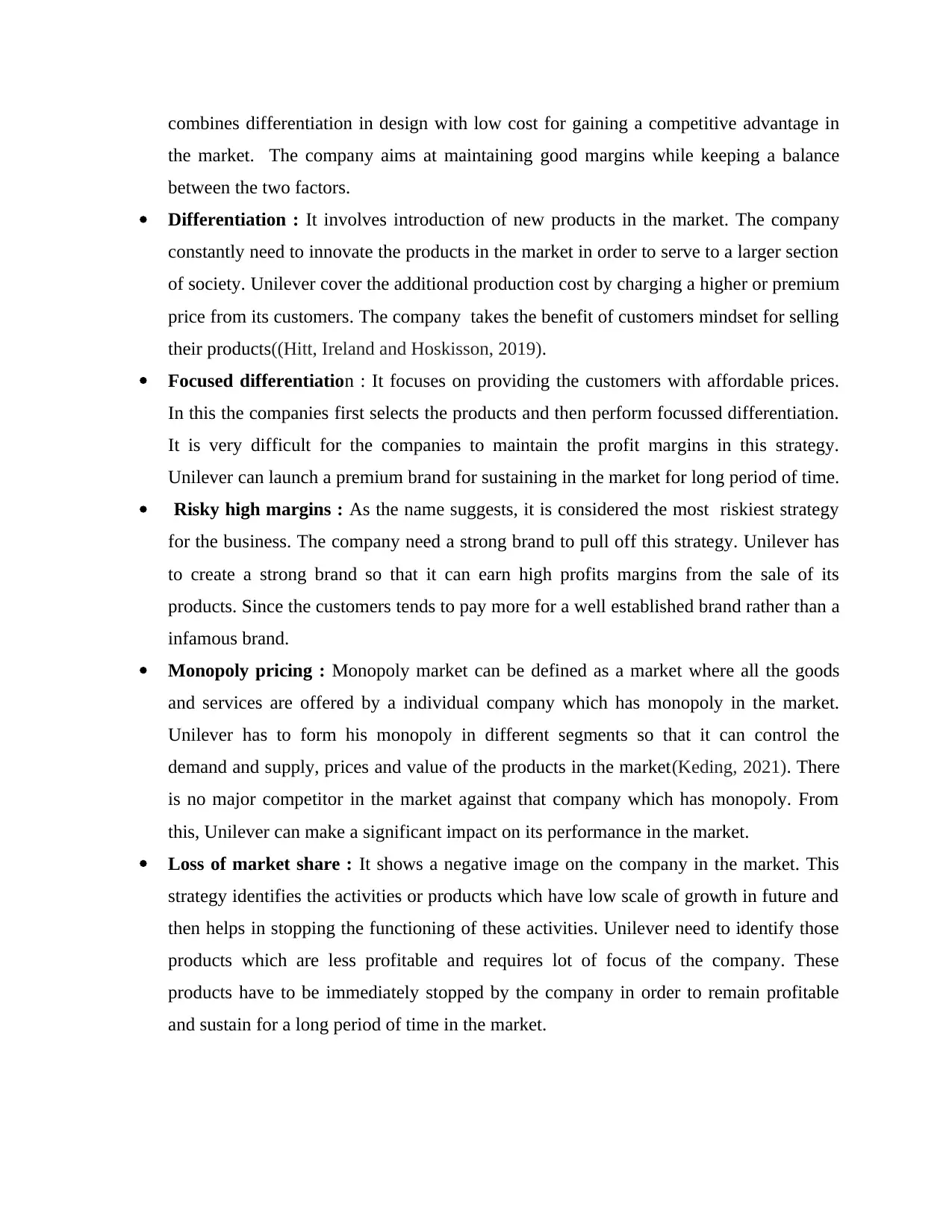
combines differentiation in design with low cost for gaining a competitive advantage in
the market. The company aims at maintaining good margins while keeping a balance
between the two factors.
Differentiation : It involves introduction of new products in the market. The company
constantly need to innovate the products in the market in order to serve to a larger section
of society. Unilever cover the additional production cost by charging a higher or premium
price from its customers. The company takes the benefit of customers mindset for selling
their products((Hitt, Ireland and Hoskisson, 2019).
Focused differentiation : It focuses on providing the customers with affordable prices.
In this the companies first selects the products and then perform focussed differentiation.
It is very difficult for the companies to maintain the profit margins in this strategy.
Unilever can launch a premium brand for sustaining in the market for long period of time.
Risky high margins : As the name suggests, it is considered the most riskiest strategy
for the business. The company need a strong brand to pull off this strategy. Unilever has
to create a strong brand so that it can earn high profits margins from the sale of its
products. Since the customers tends to pay more for a well established brand rather than a
infamous brand.
Monopoly pricing : Monopoly market can be defined as a market where all the goods
and services are offered by a individual company which has monopoly in the market.
Unilever has to form his monopoly in different segments so that it can control the
demand and supply, prices and value of the products in the market(Keding, 2021). There
is no major competitor in the market against that company which has monopoly. From
this, Unilever can make a significant impact on its performance in the market.
Loss of market share : It shows a negative image on the company in the market. This
strategy identifies the activities or products which have low scale of growth in future and
then helps in stopping the functioning of these activities. Unilever need to identify those
products which are less profitable and requires lot of focus of the company. These
products have to be immediately stopped by the company in order to remain profitable
and sustain for a long period of time in the market.
the market. The company aims at maintaining good margins while keeping a balance
between the two factors.
Differentiation : It involves introduction of new products in the market. The company
constantly need to innovate the products in the market in order to serve to a larger section
of society. Unilever cover the additional production cost by charging a higher or premium
price from its customers. The company takes the benefit of customers mindset for selling
their products((Hitt, Ireland and Hoskisson, 2019).
Focused differentiation : It focuses on providing the customers with affordable prices.
In this the companies first selects the products and then perform focussed differentiation.
It is very difficult for the companies to maintain the profit margins in this strategy.
Unilever can launch a premium brand for sustaining in the market for long period of time.
Risky high margins : As the name suggests, it is considered the most riskiest strategy
for the business. The company need a strong brand to pull off this strategy. Unilever has
to create a strong brand so that it can earn high profits margins from the sale of its
products. Since the customers tends to pay more for a well established brand rather than a
infamous brand.
Monopoly pricing : Monopoly market can be defined as a market where all the goods
and services are offered by a individual company which has monopoly in the market.
Unilever has to form his monopoly in different segments so that it can control the
demand and supply, prices and value of the products in the market(Keding, 2021). There
is no major competitor in the market against that company which has monopoly. From
this, Unilever can make a significant impact on its performance in the market.
Loss of market share : It shows a negative image on the company in the market. This
strategy identifies the activities or products which have low scale of growth in future and
then helps in stopping the functioning of these activities. Unilever need to identify those
products which are less profitable and requires lot of focus of the company. These
products have to be immediately stopped by the company in order to remain profitable
and sustain for a long period of time in the market.
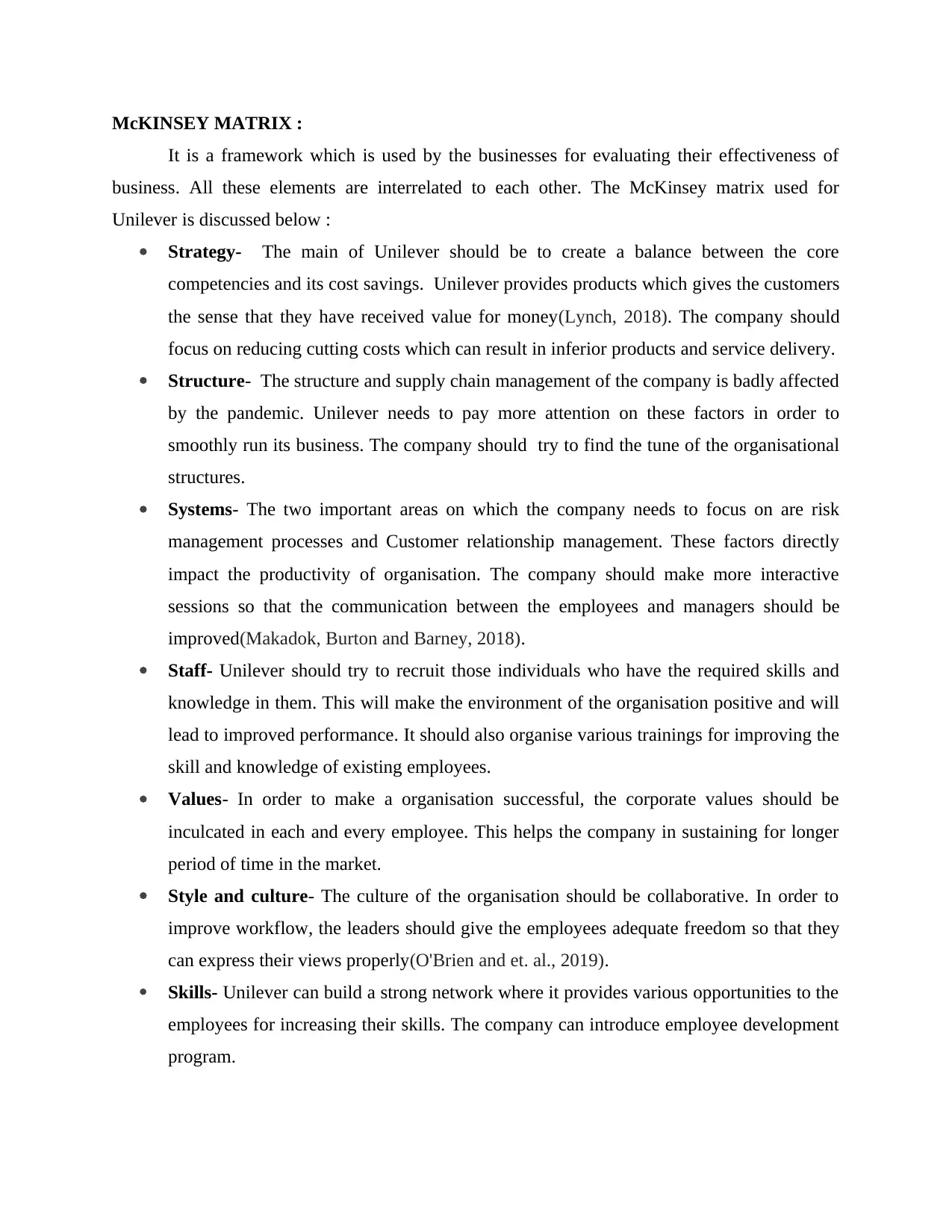
McKINSEY MATRIX :
It is a framework which is used by the businesses for evaluating their effectiveness of
business. All these elements are interrelated to each other. The McKinsey matrix used for
Unilever is discussed below :
Strategy- The main of Unilever should be to create a balance between the core
competencies and its cost savings. Unilever provides products which gives the customers
the sense that they have received value for money(Lynch, 2018). The company should
focus on reducing cutting costs which can result in inferior products and service delivery.
Structure- The structure and supply chain management of the company is badly affected
by the pandemic. Unilever needs to pay more attention on these factors in order to
smoothly run its business. The company should try to find the tune of the organisational
structures.
Systems- The two important areas on which the company needs to focus on are risk
management processes and Customer relationship management. These factors directly
impact the productivity of organisation. The company should make more interactive
sessions so that the communication between the employees and managers should be
improved(Makadok, Burton and Barney, 2018).
Staff- Unilever should try to recruit those individuals who have the required skills and
knowledge in them. This will make the environment of the organisation positive and will
lead to improved performance. It should also organise various trainings for improving the
skill and knowledge of existing employees.
Values- In order to make a organisation successful, the corporate values should be
inculcated in each and every employee. This helps the company in sustaining for longer
period of time in the market.
Style and culture- The culture of the organisation should be collaborative. In order to
improve workflow, the leaders should give the employees adequate freedom so that they
can express their views properly(O'Brien and et. al., 2019).
Skills- Unilever can build a strong network where it provides various opportunities to the
employees for increasing their skills. The company can introduce employee development
program.
It is a framework which is used by the businesses for evaluating their effectiveness of
business. All these elements are interrelated to each other. The McKinsey matrix used for
Unilever is discussed below :
Strategy- The main of Unilever should be to create a balance between the core
competencies and its cost savings. Unilever provides products which gives the customers
the sense that they have received value for money(Lynch, 2018). The company should
focus on reducing cutting costs which can result in inferior products and service delivery.
Structure- The structure and supply chain management of the company is badly affected
by the pandemic. Unilever needs to pay more attention on these factors in order to
smoothly run its business. The company should try to find the tune of the organisational
structures.
Systems- The two important areas on which the company needs to focus on are risk
management processes and Customer relationship management. These factors directly
impact the productivity of organisation. The company should make more interactive
sessions so that the communication between the employees and managers should be
improved(Makadok, Burton and Barney, 2018).
Staff- Unilever should try to recruit those individuals who have the required skills and
knowledge in them. This will make the environment of the organisation positive and will
lead to improved performance. It should also organise various trainings for improving the
skill and knowledge of existing employees.
Values- In order to make a organisation successful, the corporate values should be
inculcated in each and every employee. This helps the company in sustaining for longer
period of time in the market.
Style and culture- The culture of the organisation should be collaborative. In order to
improve workflow, the leaders should give the employees adequate freedom so that they
can express their views properly(O'Brien and et. al., 2019).
Skills- Unilever can build a strong network where it provides various opportunities to the
employees for increasing their skills. The company can introduce employee development
program.
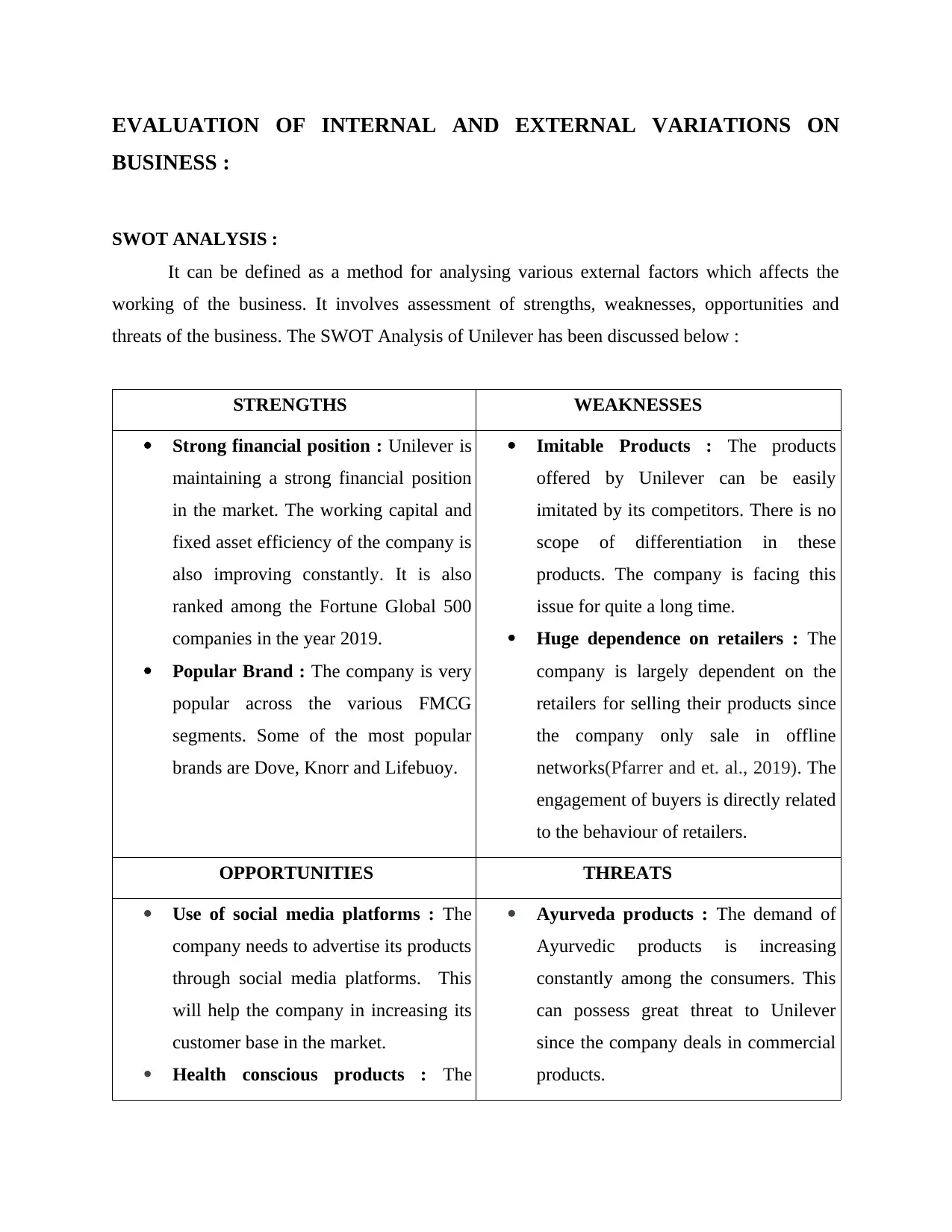
EVALUATION OF INTERNAL AND EXTERNAL VARIATIONS ON
BUSINESS :
SWOT ANALYSIS :
It can be defined as a method for analysing various external factors which affects the
working of the business. It involves assessment of strengths, weaknesses, opportunities and
threats of the business. The SWOT Analysis of Unilever has been discussed below :
STRENGTHS WEAKNESSES
Strong financial position : Unilever is
maintaining a strong financial position
in the market. The working capital and
fixed asset efficiency of the company is
also improving constantly. It is also
ranked among the Fortune Global 500
companies in the year 2019.
Popular Brand : The company is very
popular across the various FMCG
segments. Some of the most popular
brands are Dove, Knorr and Lifebuoy.
Imitable Products : The products
offered by Unilever can be easily
imitated by its competitors. There is no
scope of differentiation in these
products. The company is facing this
issue for quite a long time.
Huge dependence on retailers : The
company is largely dependent on the
retailers for selling their products since
the company only sale in offline
networks(Pfarrer and et. al., 2019). The
engagement of buyers is directly related
to the behaviour of retailers.
OPPORTUNITIES THREATS
Use of social media platforms : The
company needs to advertise its products
through social media platforms. This
will help the company in increasing its
customer base in the market.
Health conscious products : The
Ayurveda products : The demand of
Ayurvedic products is increasing
constantly among the consumers. This
can possess great threat to Unilever
since the company deals in commercial
products.
BUSINESS :
SWOT ANALYSIS :
It can be defined as a method for analysing various external factors which affects the
working of the business. It involves assessment of strengths, weaknesses, opportunities and
threats of the business. The SWOT Analysis of Unilever has been discussed below :
STRENGTHS WEAKNESSES
Strong financial position : Unilever is
maintaining a strong financial position
in the market. The working capital and
fixed asset efficiency of the company is
also improving constantly. It is also
ranked among the Fortune Global 500
companies in the year 2019.
Popular Brand : The company is very
popular across the various FMCG
segments. Some of the most popular
brands are Dove, Knorr and Lifebuoy.
Imitable Products : The products
offered by Unilever can be easily
imitated by its competitors. There is no
scope of differentiation in these
products. The company is facing this
issue for quite a long time.
Huge dependence on retailers : The
company is largely dependent on the
retailers for selling their products since
the company only sale in offline
networks(Pfarrer and et. al., 2019). The
engagement of buyers is directly related
to the behaviour of retailers.
OPPORTUNITIES THREATS
Use of social media platforms : The
company needs to advertise its products
through social media platforms. This
will help the company in increasing its
customer base in the market.
Health conscious products : The
Ayurveda products : The demand of
Ayurvedic products is increasing
constantly among the consumers. This
can possess great threat to Unilever
since the company deals in commercial
products.
Paraphrase This Document
Need a fresh take? Get an instant paraphrase of this document with our AI Paraphraser
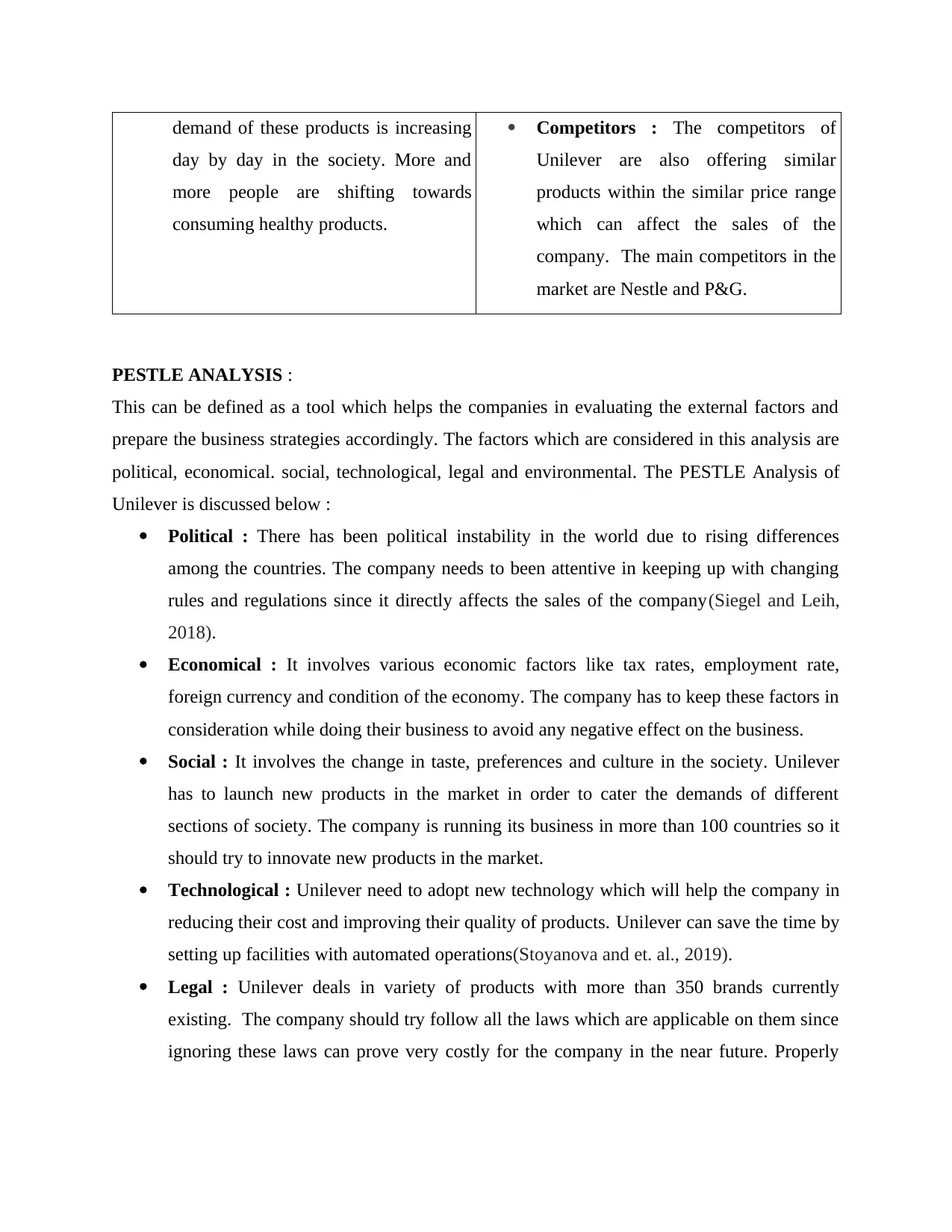
demand of these products is increasing
day by day in the society. More and
more people are shifting towards
consuming healthy products.
Competitors : The competitors of
Unilever are also offering similar
products within the similar price range
which can affect the sales of the
company. The main competitors in the
market are Nestle and P&G.
PESTLE ANALYSIS :
This can be defined as a tool which helps the companies in evaluating the external factors and
prepare the business strategies accordingly. The factors which are considered in this analysis are
political, economical. social, technological, legal and environmental. The PESTLE Analysis of
Unilever is discussed below :
Political : There has been political instability in the world due to rising differences
among the countries. The company needs to been attentive in keeping up with changing
rules and regulations since it directly affects the sales of the company(Siegel and Leih,
2018).
Economical : It involves various economic factors like tax rates, employment rate,
foreign currency and condition of the economy. The company has to keep these factors in
consideration while doing their business to avoid any negative effect on the business.
Social : It involves the change in taste, preferences and culture in the society. Unilever
has to launch new products in the market in order to cater the demands of different
sections of society. The company is running its business in more than 100 countries so it
should try to innovate new products in the market.
Technological : Unilever need to adopt new technology which will help the company in
reducing their cost and improving their quality of products. Unilever can save the time by
setting up facilities with automated operations(Stoyanova and et. al., 2019).
Legal : Unilever deals in variety of products with more than 350 brands currently
existing. The company should try follow all the laws which are applicable on them since
ignoring these laws can prove very costly for the company in the near future. Properly
day by day in the society. More and
more people are shifting towards
consuming healthy products.
Competitors : The competitors of
Unilever are also offering similar
products within the similar price range
which can affect the sales of the
company. The main competitors in the
market are Nestle and P&G.
PESTLE ANALYSIS :
This can be defined as a tool which helps the companies in evaluating the external factors and
prepare the business strategies accordingly. The factors which are considered in this analysis are
political, economical. social, technological, legal and environmental. The PESTLE Analysis of
Unilever is discussed below :
Political : There has been political instability in the world due to rising differences
among the countries. The company needs to been attentive in keeping up with changing
rules and regulations since it directly affects the sales of the company(Siegel and Leih,
2018).
Economical : It involves various economic factors like tax rates, employment rate,
foreign currency and condition of the economy. The company has to keep these factors in
consideration while doing their business to avoid any negative effect on the business.
Social : It involves the change in taste, preferences and culture in the society. Unilever
has to launch new products in the market in order to cater the demands of different
sections of society. The company is running its business in more than 100 countries so it
should try to innovate new products in the market.
Technological : Unilever need to adopt new technology which will help the company in
reducing their cost and improving their quality of products. Unilever can save the time by
setting up facilities with automated operations(Stoyanova and et. al., 2019).
Legal : Unilever deals in variety of products with more than 350 brands currently
existing. The company should try follow all the laws which are applicable on them since
ignoring these laws can prove very costly for the company in the near future. Properly
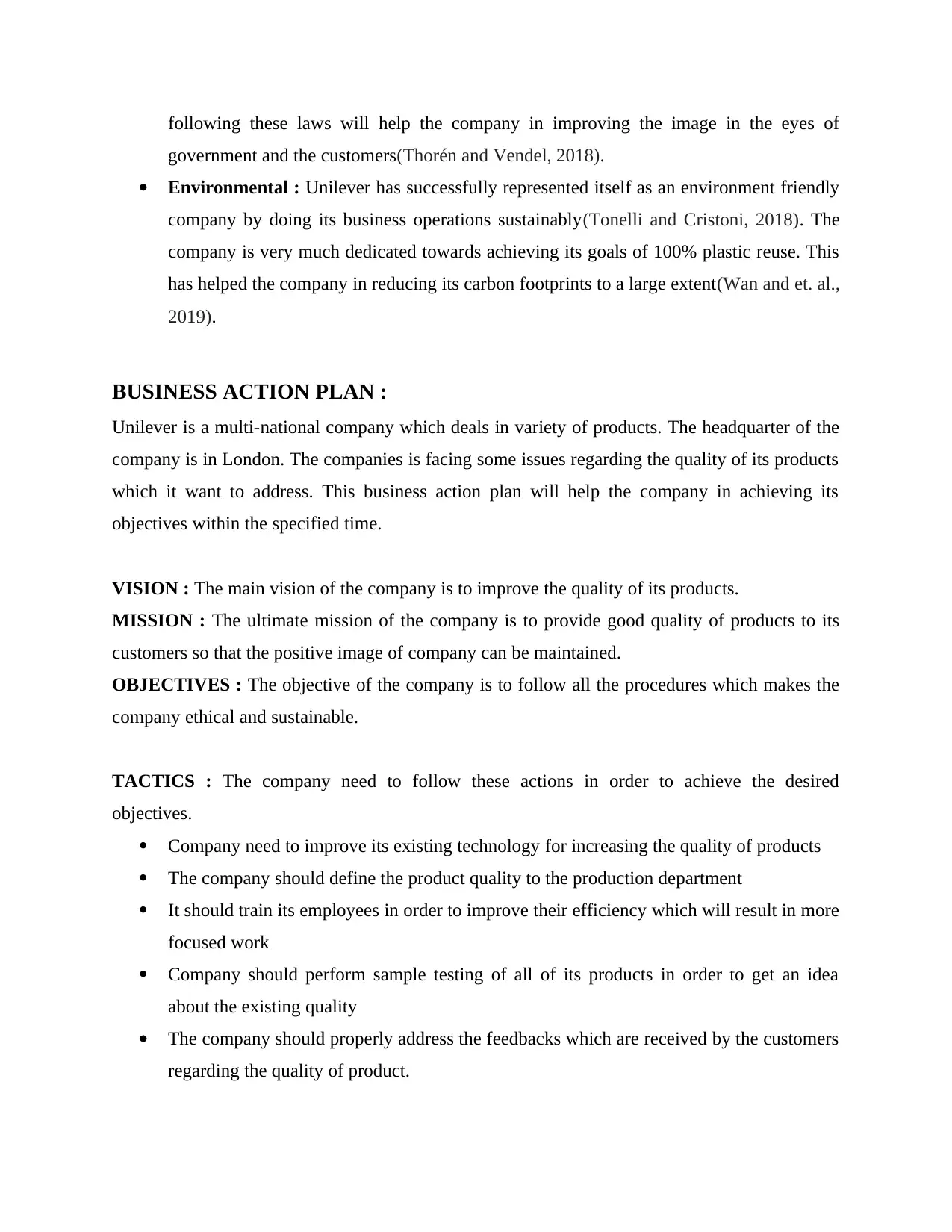
following these laws will help the company in improving the image in the eyes of
government and the customers(Thorén and Vendel, 2018).
Environmental : Unilever has successfully represented itself as an environment friendly
company by doing its business operations sustainably(Tonelli and Cristoni, 2018). The
company is very much dedicated towards achieving its goals of 100% plastic reuse. This
has helped the company in reducing its carbon footprints to a large extent(Wan and et. al.,
2019).
BUSINESS ACTION PLAN :
Unilever is a multi-national company which deals in variety of products. The headquarter of the
company is in London. The companies is facing some issues regarding the quality of its products
which it want to address. This business action plan will help the company in achieving its
objectives within the specified time.
VISION : The main vision of the company is to improve the quality of its products.
MISSION : The ultimate mission of the company is to provide good quality of products to its
customers so that the positive image of company can be maintained.
OBJECTIVES : The objective of the company is to follow all the procedures which makes the
company ethical and sustainable.
TACTICS : The company need to follow these actions in order to achieve the desired
objectives.
Company need to improve its existing technology for increasing the quality of products
The company should define the product quality to the production department
It should train its employees in order to improve their efficiency which will result in more
focused work
Company should perform sample testing of all of its products in order to get an idea
about the existing quality
The company should properly address the feedbacks which are received by the customers
regarding the quality of product.
government and the customers(Thorén and Vendel, 2018).
Environmental : Unilever has successfully represented itself as an environment friendly
company by doing its business operations sustainably(Tonelli and Cristoni, 2018). The
company is very much dedicated towards achieving its goals of 100% plastic reuse. This
has helped the company in reducing its carbon footprints to a large extent(Wan and et. al.,
2019).
BUSINESS ACTION PLAN :
Unilever is a multi-national company which deals in variety of products. The headquarter of the
company is in London. The companies is facing some issues regarding the quality of its products
which it want to address. This business action plan will help the company in achieving its
objectives within the specified time.
VISION : The main vision of the company is to improve the quality of its products.
MISSION : The ultimate mission of the company is to provide good quality of products to its
customers so that the positive image of company can be maintained.
OBJECTIVES : The objective of the company is to follow all the procedures which makes the
company ethical and sustainable.
TACTICS : The company need to follow these actions in order to achieve the desired
objectives.
Company need to improve its existing technology for increasing the quality of products
The company should define the product quality to the production department
It should train its employees in order to improve their efficiency which will result in more
focused work
Company should perform sample testing of all of its products in order to get an idea
about the existing quality
The company should properly address the feedbacks which are received by the customers
regarding the quality of product.
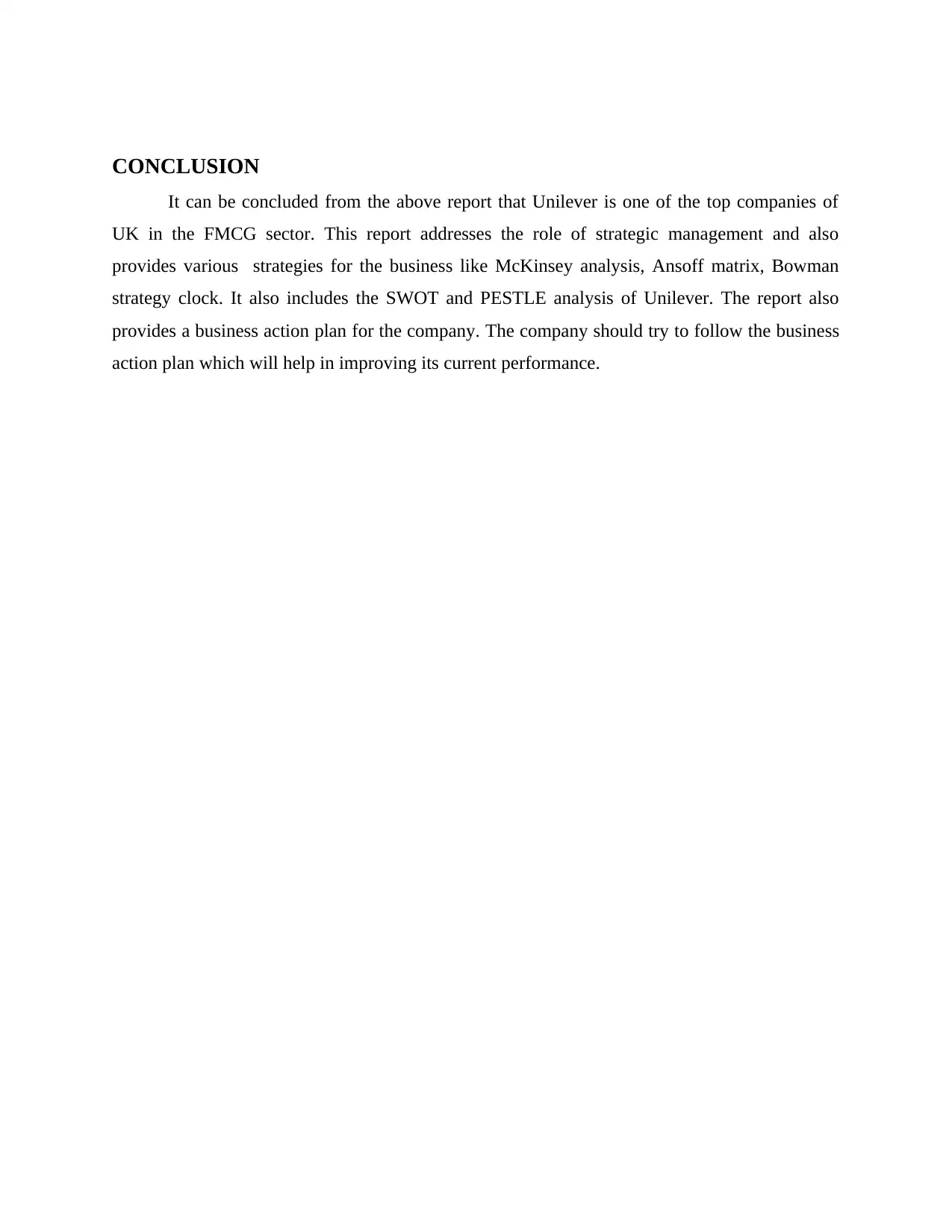
CONCLUSION
It can be concluded from the above report that Unilever is one of the top companies of
UK in the FMCG sector. This report addresses the role of strategic management and also
provides various strategies for the business like McKinsey analysis, Ansoff matrix, Bowman
strategy clock. It also includes the SWOT and PESTLE analysis of Unilever. The report also
provides a business action plan for the company. The company should try to follow the business
action plan which will help in improving its current performance.
It can be concluded from the above report that Unilever is one of the top companies of
UK in the FMCG sector. This report addresses the role of strategic management and also
provides various strategies for the business like McKinsey analysis, Ansoff matrix, Bowman
strategy clock. It also includes the SWOT and PESTLE analysis of Unilever. The report also
provides a business action plan for the company. The company should try to follow the business
action plan which will help in improving its current performance.
Secure Best Marks with AI Grader
Need help grading? Try our AI Grader for instant feedback on your assignments.
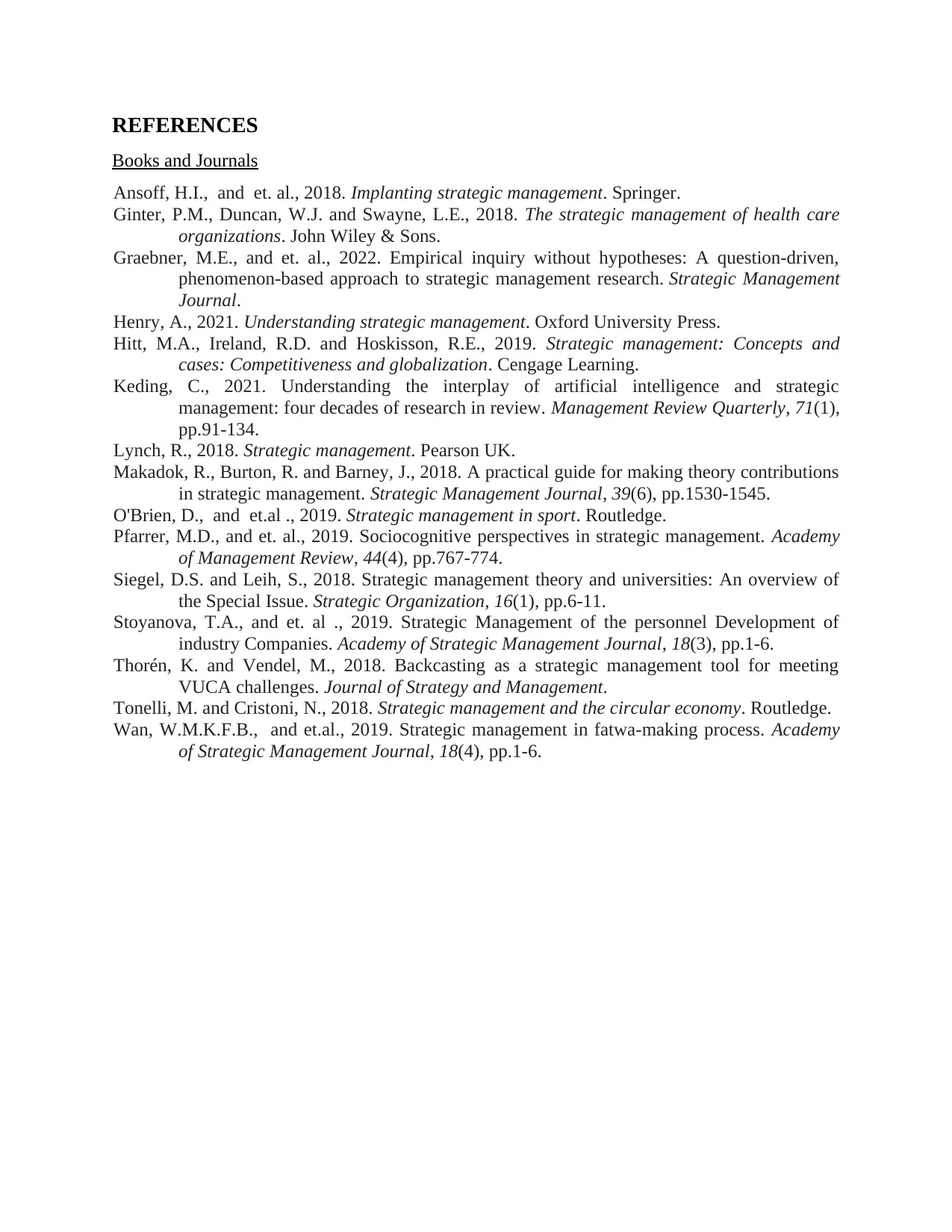
REFERENCES
Books and Journals
Ansoff, H.I., and et. al., 2018. Implanting strategic management. Springer.
Ginter, P.M., Duncan, W.J. and Swayne, L.E., 2018. The strategic management of health care
organizations. John Wiley & Sons.
Graebner, M.E., and et. al., 2022. Empirical inquiry without hypotheses: A question‐driven,
phenomenon‐based approach to strategic management research. Strategic Management
Journal.
Henry, A., 2021. Understanding strategic management. Oxford University Press.
Hitt, M.A., Ireland, R.D. and Hoskisson, R.E., 2019. Strategic management: Concepts and
cases: Competitiveness and globalization. Cengage Learning.
Keding, C., 2021. Understanding the interplay of artificial intelligence and strategic
management: four decades of research in review. Management Review Quarterly, 71(1),
pp.91-134.
Lynch, R., 2018. Strategic management. Pearson UK.
Makadok, R., Burton, R. and Barney, J., 2018. A practical guide for making theory contributions
in strategic management. Strategic Management Journal, 39(6), pp.1530-1545.
O'Brien, D., and et.al ., 2019. Strategic management in sport. Routledge.
Pfarrer, M.D., and et. al., 2019. Sociocognitive perspectives in strategic management. Academy
of Management Review, 44(4), pp.767-774.
Siegel, D.S. and Leih, S., 2018. Strategic management theory and universities: An overview of
the Special Issue. Strategic Organization, 16(1), pp.6-11.
Stoyanova, T.A., and et. al ., 2019. Strategic Management of the personnel Development of
industry Companies. Academy of Strategic Management Journal, 18(3), pp.1-6.
Thorén, K. and Vendel, M., 2018. Backcasting as a strategic management tool for meeting
VUCA challenges. Journal of Strategy and Management.
Tonelli, M. and Cristoni, N., 2018. Strategic management and the circular economy. Routledge.
Wan, W.M.K.F.B., and et.al., 2019. Strategic management in fatwa-making process. Academy
of Strategic Management Journal, 18(4), pp.1-6.
Books and Journals
Ansoff, H.I., and et. al., 2018. Implanting strategic management. Springer.
Ginter, P.M., Duncan, W.J. and Swayne, L.E., 2018. The strategic management of health care
organizations. John Wiley & Sons.
Graebner, M.E., and et. al., 2022. Empirical inquiry without hypotheses: A question‐driven,
phenomenon‐based approach to strategic management research. Strategic Management
Journal.
Henry, A., 2021. Understanding strategic management. Oxford University Press.
Hitt, M.A., Ireland, R.D. and Hoskisson, R.E., 2019. Strategic management: Concepts and
cases: Competitiveness and globalization. Cengage Learning.
Keding, C., 2021. Understanding the interplay of artificial intelligence and strategic
management: four decades of research in review. Management Review Quarterly, 71(1),
pp.91-134.
Lynch, R., 2018. Strategic management. Pearson UK.
Makadok, R., Burton, R. and Barney, J., 2018. A practical guide for making theory contributions
in strategic management. Strategic Management Journal, 39(6), pp.1530-1545.
O'Brien, D., and et.al ., 2019. Strategic management in sport. Routledge.
Pfarrer, M.D., and et. al., 2019. Sociocognitive perspectives in strategic management. Academy
of Management Review, 44(4), pp.767-774.
Siegel, D.S. and Leih, S., 2018. Strategic management theory and universities: An overview of
the Special Issue. Strategic Organization, 16(1), pp.6-11.
Stoyanova, T.A., and et. al ., 2019. Strategic Management of the personnel Development of
industry Companies. Academy of Strategic Management Journal, 18(3), pp.1-6.
Thorén, K. and Vendel, M., 2018. Backcasting as a strategic management tool for meeting
VUCA challenges. Journal of Strategy and Management.
Tonelli, M. and Cristoni, N., 2018. Strategic management and the circular economy. Routledge.
Wan, W.M.K.F.B., and et.al., 2019. Strategic management in fatwa-making process. Academy
of Strategic Management Journal, 18(4), pp.1-6.
1 out of 11
Related Documents
Your All-in-One AI-Powered Toolkit for Academic Success.
+13062052269
info@desklib.com
Available 24*7 on WhatsApp / Email
![[object Object]](/_next/static/media/star-bottom.7253800d.svg)
Unlock your academic potential
© 2024 | Zucol Services PVT LTD | All rights reserved.





